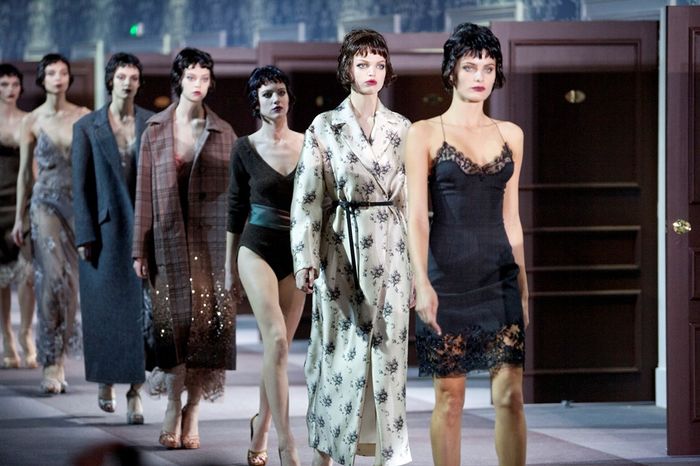Victoria’s Secret: Rebranding Masculine Fantasies
Magdalena Gabrysiak examines how the recent rejuvenation of Victoria’s Secret rejects its male-tailored origins, seeking to create a lingerie brand inclusive for all

Content Note: brief mention of unhealthy weights
Last month, in an attempt to salvage their consistently declining market share, global lingerie brand Victoria’s Secret announced a new marketing strategy: replacing its signature supermodels with modern, trailblazing women. The newly unveiled Victoria’s Secret Collective — a group of seven female ambassadors including actress Priyanka Chopra, athlete Megan Rapinoe, and plus-size model Paloma Elsesser — will embody the brand’s ‘What Women Want’ image, while advising a female-dominated board of directors.
The end of the infamous Angels triggered by scrapping the annual Victoria’s Secret fashion show has sparked cultural outrage, mostly stemming from male commentators. From Adam Sosnick defiantly dubbing it ‘the unsexification of America’, to YouTuber Steven Crowder sarcastically thanking feminism for ‘ruining Victoria’s Secret’, the company’s careful rebranding has ushered in heavy criticism. But why do these men care so deeply about the marketing of products they would never wear and rarely shop for? Why do they seem so confident in their assertion that ‘lingerie is only for men’? Looking to the male-centred origins of the Victoria’s Secret brand and the cultural shifts that accompanied its formation can teach us much about such dissonance.
Victoria’s Secret was founded in 1977 by Roy Raymond who claimed to have conjured up the idea when he went lingerie-shopping for his wife. He found the entire experience embarrassing and uninteresting for him as a man, faced with a limited selection of mundane, monochromatic items. Raymond’s lingerie store instead sought to create a male-friendly environment enabling men to feel comfortable choosing excitingly exotic undergarments for their female partners or mistresses. Such a strategy worked better than expected but, since little women shopped in his stores, the business came close to filing for bankruptcy in the early 1980s. All this changed when the brand was bought by burgeoning businessman Les Wexner for $1 million in 1982, starting strong with a fierce marketing campaign centred around skinny, conventionally attractive white women.
“lingerie mirrors masculine fantasies, designed exclusively for men to look at rather than for women to wear”
While at the time, Raymond critiqued Wexner’s Victoria’s Secret catalogues as ‘soft porn’, the brand immediately started gathering attention at unprecedented speed. By 2014, Victoria’s Secret had 670 stores in the United States alone, and its $1.9 billion in sales made it the most popular apparel brand globally. What really contributed to the company’s immense success, however, was its annual Victoria’s Secret Fashion Show, quickly becoming mainstream entertainment marvelled at by many across the world.
I remember watching the Victoria’s Secret show at a sleepover with a group of friends, entirely unaware that the spectacle of musical performances and perfectly dressed pop-stars was advertising lingerie. All we could do was watch the skinny, tall and predominantly white women strut down the runway. That night, our popcorn was discarded as we took to the bathroom mirror, weighing and measuring ourselves in frustration. We were fifteen years old.
Laura Tempesta — an academic researcher in lingerie design and the founder of Bravolution — describes the former Victoria’s Secret marketing strategy as imposing the male-gaze onto female lingerie, prioritising surface-level appearance over any semblance of structure or comfort. She points out that the bra as we know it is ‘over one hundred years old’ with its technology far from perfect — indeed, painful for the majority of women — having always been tailored towards masculine preferences. A 2006 Harris Interactive study conducted in North America even discovered that 59% of women found their bra caused excessive pain.
The origins of both the bra and the boldly sexualised Victoria’s Secret brand prove lingerie mirrors masculine fantasies, designed exclusively for men to look at rather than for women to wear. The brand-name Victoria’s Secret alone cheekily implies prioritising the spectator over the wearer of the lingerie. If someone wants to buy a piece of lingerie solely for aesthetics purposes to feel more appealing, they should be able to do so. The true problem begins once focusing on your appearance becomes not a choice but part of an oppressive body-image norm, leading consumers to believe that discomfort is inevitable. Looking to the future, we can hope the newly founded Victoria’s Secret Collective will prevail against backlash and create a space that ‘sees the true spectrum of ALL women’ in the words of Megan Rapinoe. The needs, desires and comfort of all people must be kept at the core of all lingerie fashion.
 News / Uni Scout and Guide Club affirms trans inclusion 12 December 2025
News / Uni Scout and Guide Club affirms trans inclusion 12 December 2025 News / Cambridge Vet School gets lifeline year to stay accredited28 November 2025
News / Cambridge Vet School gets lifeline year to stay accredited28 November 2025 Science / Did your ex trip on King’s Parade? The science behind the ‘ick’12 December 2025
Science / Did your ex trip on King’s Parade? The science behind the ‘ick’12 December 2025 News / Cambridge study finds students learn better with notes than AI13 December 2025
News / Cambridge study finds students learn better with notes than AI13 December 2025 News / Pembroke to convert listed office building into accom9 December 2025
News / Pembroke to convert listed office building into accom9 December 2025








